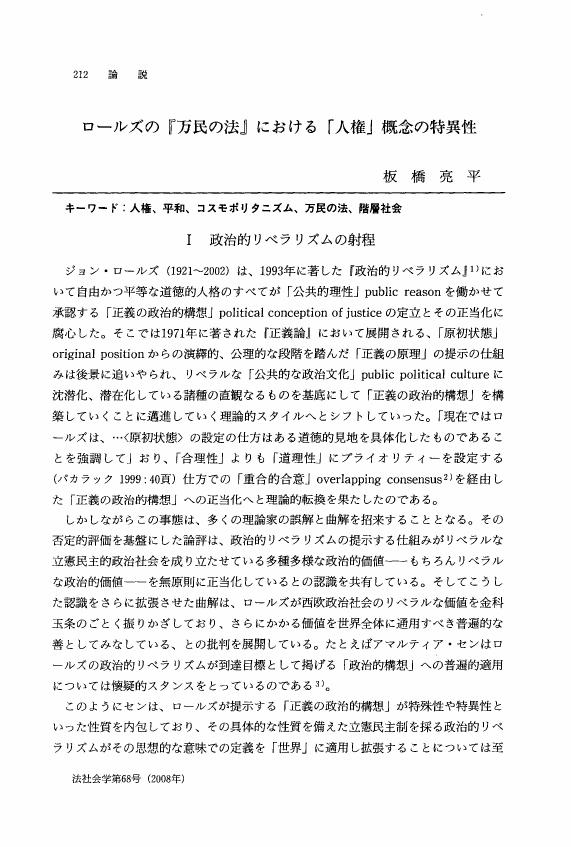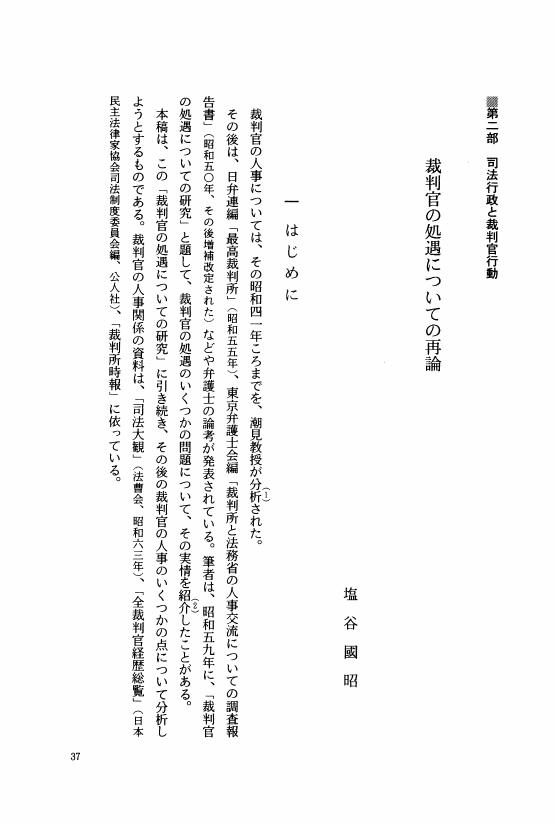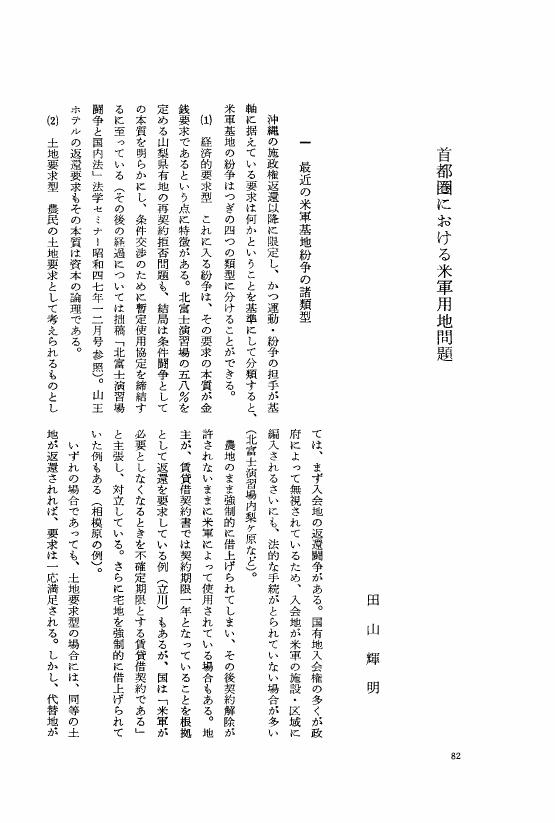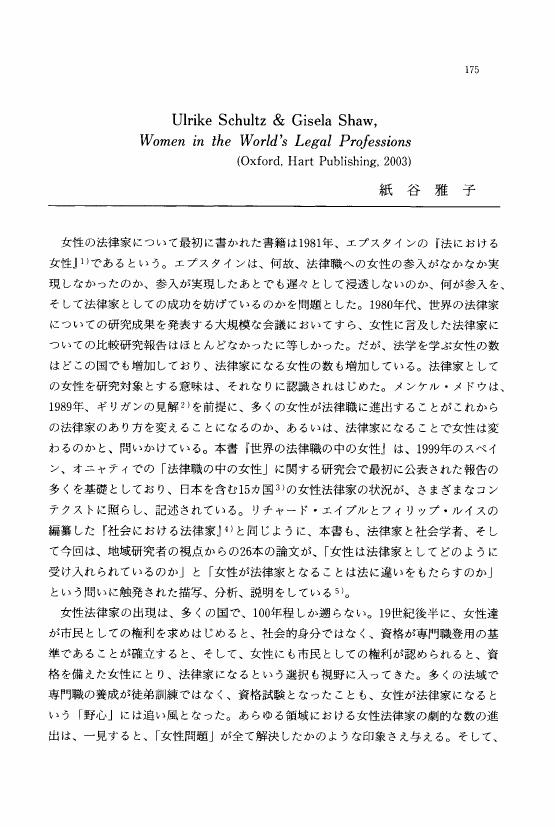1 0 0 0 OA 穗積法学末弘法学の分析と批判 (座談会)
- 著者
- 磯田 進 平野 義太郎 戒能 通孝 仁井田 陞 川島 武宜 福島 正夫
- 出版者
- The Japanese Association of Sociology of Law
- 雑誌
- 法社会学 (ISSN:04376161)
- 巻号頁・発行日
- vol.1952, no.2, pp.53-83, 1952-04-15 (Released:2009-04-03)
1 0 0 0 OA 法社会学におけるモデル構築法
- 著者
- 小室 直樹
- 出版者
- The Japanese Association of Sociology of Law
- 雑誌
- 法社会学 (ISSN:04376161)
- 巻号頁・発行日
- vol.1975, no.28, pp.102-109, 1975-10-10 (Released:2009-01-15)
- 参考文献数
- 1
1 0 0 0 OA ロールズの『万民の法』における「人権」概念の特異性
- 著者
- 板橋 亮平
- 出版者
- 日本法社会学会
- 雑誌
- 法社会学 (ISSN:04376161)
- 巻号頁・発行日
- vol.2008, no.68, pp.212-230, 2008 (Released:2017-01-31)
1 0 0 0 OA 2つの逸脱主義的運動
- 著者
- 吾妻 聡
- 出版者
- The Japanese Association of Sociology of Law
- 雑誌
- 法社会学 (ISSN:04376161)
- 巻号頁・発行日
- vol.2005, no.63, pp.186-216,267, 2005-09-30 (Released:2011-04-13)
- 参考文献数
- 44
In this paper, I, first, examine the controversy on the rights system and discourse between the critique of rights by Critical Legal Scholars and the vindication of rights by Critical Race Theorists. This examination urges me to contend that what is needed is not abandonment of liberal rights but reconstructive approach to the existing institutional arrangements of liberal rights. To envisage and acquire the direction toward another conception and system of rights, I follow Roberto Unger's methodology (deviationist doctrine) and normative argument of social theory. Unger's radical project (Empowered Democracy or Super-liberalism) proposes alterative vision of more egalitarian and democratized society whose structures (formative contexts), Unger insists, are more self-revisable and plastic. I find out a supportive example for Unger's vision in the practice and ideal of so-called "New Social Movements, " and attempt to elucidate their stake and aspiration for more egalitarian and democratic social settings in private sphere. My sense is that Unger's vision is not at all far from the ideal of society and human association which is an emergent germination but still labeled as deviant. Finally, I turn into Unger's legal theory version of deviant doctrine and proposal, and paraphrase "immunity rights" and "destabilization rights." Even though these alternative proposal of rights is controversial and is frequently criticized for its idiosyncrasy and paradoxical characteristic, I contend that its ideals of heightening the context-revising capability of human beings and the self-revising character of institutional arrangements are essential not only because we can see its emergent germ in the movements' practices in private sphere, but also because ultimate justification of constitutional order comes from active invitation of ceaseless criticism toward the existing social settings and institutional arrangements by ordinary men and women. The deviant moment has to be interpreted as the representation of universal ideal of democracy.
1 0 0 0 OA 裁判官の処遇についての再論
- 著者
- 塩谷 國昭
- 出版者
- The Japanese Association of Sociology of Law
- 雑誌
- 法社会学 (ISSN:04376161)
- 巻号頁・発行日
- vol.1991, no.43, pp.37-45, 1991-04-30 (Released:2009-01-15)
- 参考文献数
- 4
1 0 0 0 OA 「翻訳」と法的現実のモザイク
- 著者
- 中河 伸俊
- 出版者
- The Japanese Association of Sociology of Law
- 雑誌
- 法社会学 (ISSN:04376161)
- 巻号頁・発行日
- vol.2003, no.58, pp.79-97,273, 2003-03-30 (Released:2009-04-22)
- 参考文献数
- 51
Claims-making is a key concept in constructionist studies on social problems. This concept makes it possible to see both social problems and legal phenomena as process-achievements within a sequence of situated activities. From this claims-making perspective, this paper proposes a few research topics. One of those is a "translation" problem. A various "social problem" claims and "everyday" claims are inevitably "translated" into legal claims when they move into legal arena. What various parties, including legal and other experts, do when the "translation" is taking place is an important question, both theoretically and practically.
1 0 0 0 OA 過労死と法社会学
- 著者
- 川人 博
- 出版者
- The Japanese Association of Sociology of Law
- 雑誌
- 法社会学 (ISSN:04376161)
- 巻号頁・発行日
- vol.2005, no.62, pp.134-138,195, 2005-03-30 (Released:2011-04-13)
- 参考文献数
- 9
The term "karoshi" was first used by Dr. Tetsunojyo Uehara and others in the latter half of the 1970s. Thanks to the activities of the Karoshi Hotline since 1988, "karoshi" has become part of the Japanese language.Karoshi is defined as "death from overwork and stress". The phrase "suicide resulting from overwork, " as a form of karoshi, is now established in Japan as well. When reported overseas, the term "karoshi" is either left in the original Japanese as karoshi, or is translated into the phrase "death from overwork" and is regarded as a symbol of overworking Japanese society.Karoshi has great significance for the following two reasons: firstly, the word explains the social factor of "overwork and stress" that leads to death; and secondly, the word has an easily understandable meaning for the Japanese people. For these two reasons, karoshi has become a locomotive for the movement of social reform in Japan.
- 著者
- 樫村 志郎
- 出版者
- 有斐閣
- 雑誌
- 法社会学 (ISSN:04376161)
- 巻号頁・発行日
- no.79, pp.229-234, 2013
1 0 0 0 性暴力と法:法律実務家の経験から
- 著者
- 角田 由紀子
- 出版者
- The Japanese Association of Sociology of Law
- 雑誌
- 法社会学 (ISSN:04376161)
- 巻号頁・発行日
- vol.2001, no.54, pp.44-58,259, 2001
The situation regarding victims of sexual violence has dramatically changed in this decade in Japan. Mainly women activists who addressed the issue of victim's rights of sexual violence have made this change. The number of victims who seek legal remedies has increased. This movement has made it clear that our legal system has not worked well for giving them appropriate remedies.<br>In the field of criminal law, rape is still determined under the influence of the patriarchal ideology. For example, rape is determined whether a victim made utmost resist against her offender. This way of determination can release rapists who know the victims, because in those cases it is more difficult for them to resist strongly. In addition, it is not likely for the victims of non-stranger rape to report the rape to the police. Victims still have faced the victim-blaming attitude of the society as a whole as well as a legal system itself. The above mentioned problem of the criminal law has also been seen in civil cases in which victims are demanding compensations from offenders. This happened particularly in sexual harassment lawsuits. The cases in which plaintiffs were defeated were determined by judges who relied on so called rape myth. Another problem of the civil cases is low amount of compensation, even though in some cases we can see relatively high amount of it.<br>The root cause of the problem is that there is merely education of sexual discrimination in the legal department of universities and the Legal Research and Training Institute run by the Supreme Court. The change of the issue of women's rights, which happened internationally in this decade, has not yet reached those educational bodies for lawyers.
1 0 0 0 OA 公共性の社会学/社会学の公共性
- 著者
- 土場 学
- 出版者
- 日本法社会学会
- 雑誌
- 法社会学 (ISSN:04376161)
- 巻号頁・発行日
- vol.2008, no.68, pp.51-64, 2008 (Released:2017-01-31)
- 著者
- 見平 典
- 出版者
- 有斐閣
- 雑誌
- 法社会学 (ISSN:04376161)
- 巻号頁・発行日
- no.83, pp.99-109, 2017
1 0 0 0 OA 行政改革
- 著者
- 森田 朗
- 出版者
- The Japanese Association of Sociology of Law
- 雑誌
- 法社会学 (ISSN:04376161)
- 巻号頁・発行日
- vol.2001, no.55, pp.71-85,248, 2001-09-30 (Released:2009-01-15)
Since mid 1990s Japan has been promoting a big scale reform of the basic governmental institutions. Transfer of functions to local goverments, deregulation, reshuffle of government ministries and financial structure reform are advancing and the civil service reform has just started. These reforms are to reform a govermental organization that has grown excessively large and rigid, and to realize a streamlined, efficient and transparent goverment that permits effective execution of important state functions. In this article, political or law-making process of two reforms are analyzed. One is the reinforcement of cabinet functions. In order for the Cabinet to conduct substantial policy discussions, and to function as the principal instrument for a top-down approach to the formation and execution of policy, it is necessary to reinforce the Cabinet functions and to strengthen the "leadershp of the Prime Minister" The second is the establishment of independent administrative corporations. Government organizations are criticized because of inefficiency, rigidity and a big financial deficit. So independent administrative corporations are established as a strong tool for increasing efficiency and improving the quality of administrative services.
- 著者
- 西尾 広毅
- 出版者
- The Japanese Association of Sociology of Law
- 雑誌
- 法社会学 (ISSN:04376161)
- 巻号頁・発行日
- vol.2002, no.56, pp.234-251,280, 2002
In this article, I analyze comparatively two litigation movements, Minoo <i>chukonhi</i> war memorial case and Osaka enthronement ceremony and <i>daijosai</i> Shinto ritual case, from the perspective of A. Melucci's theory of 'new socialmovement'. Through this comparative analysis, I clarify that a dynamism that generate in the tension between a formation of social movement identity and a conduct of lawsuit, impacts upon develop and decline of the movement as whole. On the one hand, when the litigation is conducted without taking into account on the moment of formation and/or affirmation of the collective identity, there is the risk that the collective identity, and therefore the movement as such, may collapse, even though some fruits are acquired through the litigation. On the other, when the lawsuit is conducted taking into account on the moment of formation and/or affirmation of the collective identity, there is a potential for generating new movements through legal technical refinements in that lawsuit, even if the lawsuit is end up with losing.
1 0 0 0 犯罪観の変遷と刑罰の役割
- 著者
- 松原 英世
- 出版者
- The Japanese Association of Sociology of Law
- 雑誌
- 法社会学 (ISSN:04376161)
- 巻号頁・発行日
- vol.2006, no.65, pp.67-81,254, 2006
This paper aims at bringing up a perspective to examine the relationship between policies and recognition of facts behind them. First, we will observe transformation of criminological thought and ways of dealing with crime, and confirm the correspondence, looking back to history of criminology (II). Then, we will explore what causes the transformation and how a certain policy is chosen (III). I will make the point through the work that ways of coping with crime and roles of punishment are influenced by our ways of thinking about crime and criminals rather than effectiveness of policies, and also that we should reconsider current policies for crime and how to use punishment in the historical context from this point of view.
1 0 0 0 OA 法曹一元論の原点
- 著者
- 戒能 通厚
- 出版者
- 日本法社会学会/有斐閣
- 雑誌
- 法社会学 (ISSN:04376161)
- 巻号頁・発行日
- vol.2000, no.53, pp.29-45,245, 2000-12-20 (Released:2009-01-15)
- 参考文献数
- 16
Legal Profession of Japan was created after the Meiji Restoration. Since the government did not intend to develop a strong private bar that could represent citizens in disputes, the primary objective of securing the law graduates through hard exam. for the government was to produce judges, prosecutors and upper-level state bureaucrats. After the World War II, the Practicing Attorneys Act was revised to put practicing lawyers on equal footing with prosecutors and judges. Since then, members of all three groups follow a similar path. However, the route to judgeship in Japan starts with a kind of apprenticeship as an assistant judge followed by the promotion system in the Japanese court hierarchies as 'independent and full time judge', Although law is a popular undergraduate major in Japan, a degree from law department is not prerequisite to sitting for the National Bar Exam. which is said to be the most difficult exam. in Japan.Last year, the government had appointed the Judicial Reform Committee chaired by Prof. Koji Sato of Kyoto University and the Committee is now preparing Interim Report mainly focusing on the increase of the number of Bengoshi (attorney at law) as well as reform of Bengoshi-system for much easier access to Bengoshi.Some bengoshi groups are now promoting Hoso-Ichigen (Anglo-American System of the judicial appointments) which is simply to limit the resource of judge to practicing bar (or prosecutors) in order to abolish bureaucratic judgeship ruled by the General Secretariat to the Supreme Court.This article is discussing the historical origin of the notion of Hoso-Ichigen as well as the independence of Bengoshi and also criticizing the introduction of Japanese version of Law School system into universities without any prospect of the realization of Judicial Reform in Japan.
1 0 0 0 OA 婚姻と届出に関する一考察
- 著者
- 久武 綾子
- 出版者
- 日本法社会学会/有斐閣
- 雑誌
- 法社会学 (ISSN:04376161)
- 巻号頁・発行日
- vol.1964, no.16, pp.81-106,147, 1964-04-10 (Released:2009-06-16)
- 参考文献数
- 7
以上の調査結果は、(1) 調査区は、いずれも職業別人口構成を異にするが、総括的にみると、推計学的に検定した結果も統計上の有為差は、一部の統計結果を除き、殆んど認められなかったので、本調査の地域差は期待に反し、顕著な差ではないことがわかった。(2) 婚姻届出日と第一子出生日との隔たりについての統計結果から、妊娠または出産を契機として入籍するという一慣行、すなわち、事実婚より法律婚への転機の一原因が実証された。このことは、戦前は勿論、戦後も意外に多いことがわかった。(3) 婚姻の届出が第一子の出生後、出生届の期間内の一四日までになされる率は、いずれの時代でも相当数を占め、最近でもこのような例は稀でないことがわかった。(4) 婚姻成立後、九~一〇月で子の出生をみる傾向は、最近になってようやくあらわれた。(5) 古い時代はとくに、現在でも内縁期間中の懐胎が相当多く、これは挙式後婚姻の届出がすぐに行なわれなかったためである。(6) 挙式日と出生日との隔たりについての統計結果は、時代の推移にかかわらず一〇月にピークがみられる。(7) 社会生活上、挙式は重大な規範であり、厳守されているが、その反面、制度としての婚姻の届出は、おくれがちであることが実証された。(8) 婚姻の届出は、挙式後一ケ月までになされる率が、調査区および調査期間とは関係なく一番多かった。(9) 以上、これらの調査結果から、婚姻にみられる慣習規範と、二、三の慣行が統計的に裏づけられた。(10) 本調査により、大都市における婚姻と届出に対する一般市民の実態が明らかになったが、今後は、調査地を農村に求めてこれと比較するとともに、進んでは、届出制度そのものに対する法社会学的背景を探究するための若干の調査と考察を試みたいと思う。
1 0 0 0 OA 児童虐待と子育て支援
- 著者
- 原田 綾子
- 出版者
- 日本法社会学会/有斐閣
- 雑誌
- 法社会学 (ISSN:04376161)
- 巻号頁・発行日
- vol.2006, no.65, pp.217-241,258, 2006-09-30 (Released:2012-06-20)
- 参考文献数
- 58
Every child protection system has two primary goals: to ensure the safety of children and to preserve the parent-child relationship. However, in the United States especially, the juxtapositioning of these two goals are thought to bring about a serious dilemma. According to the liberal thought, which places much value on the autonomy and self-reliance, state intervention to the family must be kept at a minimum. It therefore follows that parents do not get any support unless they are found to be abusive to their children. Under this ideology, parents are blamed in cases of child abuse because it is thought that the parents hold full responsibility for raising their own children. Parental rights are terminated to keep the child safe if the parent (s) cannot improve their parental abilities after a temporary period of assistance. Some possibilities for overcoming the problems of these contrasting alternatives can be found in the arguments of E. F. Kittay and M. Minow. They reconstruct liberal theory using the concepts of "dependency" and "relationship" and argue that society should acknowledge the social value of the parent-child relationship and support parents. If generous support for parents can reduce the parental stress, it will help prevent abuse from the outset, or at least prevent its recurrence. The latest practices on this theory can be appreciated to have broadened the possibility of concurrently realizing the two original goals: the safety of children and the preservation of the parent-child relationship.
1 0 0 0 OA <暴力の法社会学> に向けて-基調報告
- 著者
- 石田 眞
- 出版者
- 日本法社会学会/有斐閣
- 雑誌
- 法社会学 (ISSN:04376161)
- 巻号頁・発行日
- vol.2001, no.54, pp.1-12,257, 2001-03-30 (Released:2009-01-15)
- 参考文献数
- 30
Violence has existed and still exists as a fact of our every day life, but has not been on the surface as an object of social science or the humanities in Japan. Rather, it has been ignored. However, recently the subject of violence has come into sight in social science and the humanities. If the 20th Century was the "Century of Violence", then the 21st Century will be the "Century of Facing Violence". Therefore, the theme "Law and Violence" is demanded by the times.The subject of violence has been ignored even in jurisprudence. Although violence is an essential part of modern law, it has been invisible. First, modern law designated violence as the use of unlawful force against another. That is to say, the use of force within the law or with the law's permission was ignored. Second, modern law is divided into the public and private spheres, with the law only interfering in the former (public sphere), ignoring violence in the private sphere like the home and school. Third, modern law considers the courts, as places of judgement, to be a world free from violence, yet ignores the violence that occurs there (such as second rape).The purpose of my paper is to prepare for the socio-legal studies of violence. It is an attempt to put together socio-legal research related to violence. In preparing it, I first focused on the institutional area. I asked who exercises legal force and how. Research in this area comes from a great deal of substantiated evidence concerning punishment, police, public prosecutors and courts. Second, I looked at the cultural and historical area. Here, I asked what the differences are in the make up of law's violence in different cultures and in different eras. Research in this area was accumulated from legal anthropology and the historical sociology of law. Third is the area of law itself. Here, I asked what impact law's violence has on the law. Research into the area of the jurisprudence of violence has just begun. I have attempted in this paper to theorize on the socio-legal studies of violence by analyzing critically modern law through an understanding of the problem of violence that has developed in the law.
1 0 0 0 OA 首都圏における米軍用地問題
- 著者
- 田山 輝明
- 出版者
- 日本法社会学会/有斐閣
- 雑誌
- 法社会学 (ISSN:04376161)
- 巻号頁・発行日
- vol.1973, no.26, pp.82-86, 1973-10-10 (Released:2009-01-15)
- 著者
- 紙谷 雅子
- 出版者
- 日本法社会学会/有斐閣
- 雑誌
- 法社会学 (ISSN:04376161)
- 巻号頁・発行日
- vol.2005, no.62, pp.175-179, 2005-03-30 (Released:2011-04-13)
- 参考文献数
- 11






